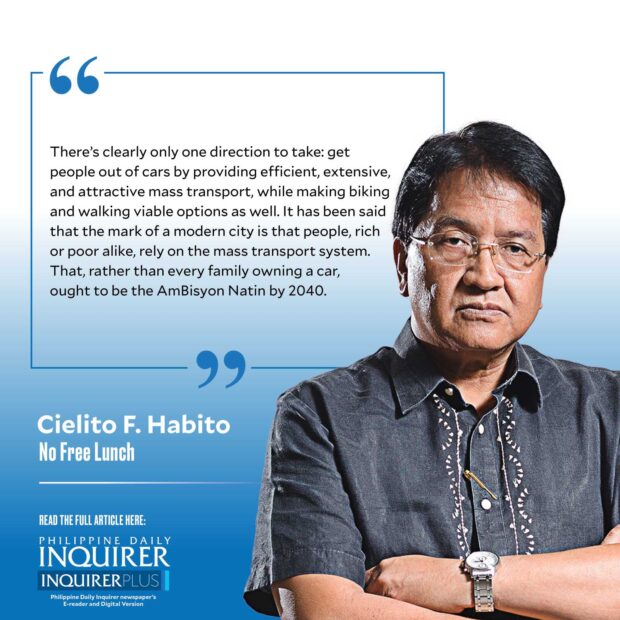A holistic traffic strategy

Marcos wants a holistic approach in solving the Philippines’ traffic woes,” Socioeconomic Planning Secretary Arsenio Balisacan announced last week in a Palace press briefing. It rang a familiar note, because nearly 12 years ago, I wrote an article here titled “Wanted: holistic traffic planning” (6/11/12). In that span of time, we hardly made any headway in fixing a problem that has plagued us for decades. The Japan International Cooperation Agency (Jica) employed a holistic framework back then to help us address the traffic problem, built on three E’s: engineering, enforcement, and education.
Japan, consistently our single largest donor, has funded numerous projects to address Metro Manila traffic congestion, ranging from technical studies to infrastructure and engineering solutions. The blue “Love Buses” that plied Metro Manila routes in the 1980s were part of the first Japanese government assistance to our transport sector. They subsequently funded a railway commuter line to Carmona, Cavite; the LRT Line 2; a computerized traffic signal system; and the construction or improvement of various major roads, flyovers, and interchanges. Belgium, Australia, the World Bank, and others supported other similar transport sector projects through the years.
Still, traffic keeps worsening over time, as if we keep throwing tons of often-borrowed money at a problem that just won’t go away. One thing is clear: engineering is far from enough. It must begin with proper planning, and there has indeed been a virtual alphabet soup of transport plans for Metro Manila, with acronyms like UTSMMA, MMETROPLAN, MMUTIP, JUMSUT, MMUSTRAP, MMUTIS, and MUCEP (whose meanings probably escape even our veteran transport experts). But government’s track record at implementing the best of plans has always been abysmal. Worse, enforcement (Jica’s second E) of traffic rules and basic road discipline is a joke in this country where laws and rules are said to be mere suggestions—until enforcers use them to squeeze bribes out of hapless motorists, often even with concocted rules. Obedient drivers who keep in their proper lane and wait for their turn lose out to those who don’t but never get apprehended anyway. We see public roadsides routinely used for parking or commercial spaces, unduly impeding traffic flow. Tricycles, pedicabs, and now e-trikes hog national roads supposedly off limits to them, risking their own safety as they slow highway travel.
The third E, education, applies to traffic enforcers, motorists, passengers, and pedestrians alike. Too many people just don’t seem to know, understand, or appreciate traffic rules and their importance enough. These must be part of everyone’s education, starting from the very young, and begins with instilling basic courtesy and discipline. These qualities seem second nature in Japan and other progressive societies, but alas, are now a rarity in our own midst. Traffic enforcers could perhaps use special training. I’ve seen too many of them manually override traffic lights and actually make things worse. One wonders if they drive a motor vehicle at all, and experience firsthand the travails of a motorist caught in the jams they often needlessly create.
To be even more holistic, I’d add a fourth E—economics—to Jica’s three. Singapore has long used economic solutions to ease traffic congestion. They make car ownership expensive through a pricey certificate of entitlement required to buy a car. They make motorists pay a variable charge (based on actual traffic conditions) to enter congestion-prone zones, and reported up to 76 percent reduction in traffic in the central city district. London and other cities copied the system, and within 10 years of introducing the scheme, London raised 2.6 billion British pounds, much of it invested to improve public transport facilities and infrastructure.
If the March-April 2023 data from the Land Transportation Office (LTO) is indicative, roughly 37,000 new additional four-wheel vehicles are now being registered each month in Metro Manila alone, the bulk being cars and SUVs. But here’s the crunch: LTO also reveals that more than half of motor vehicles on the road are not even registered. And considering many more vehicles from neighboring regions entering the metropolis on any given day, it all means that far more than 37,000 (likely twice or more!) are being added to the city streets as every month passes! There’s clearly only one direction to take: get people out of cars by providing efficient, extensive, and attractive mass transport, while making biking and walking viable options as well. It has been said that the mark of a modern city is that people, rich or poor alike, rely on the mass transport system.
That, rather than every family owning a car, ought to be the AmBisyon Natin by 2040.
cielito.habito@gmail.com





















